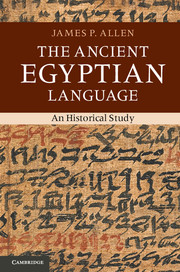1 - Ancient Egyptian
Published online by Cambridge University Press: 05 July 2013
Summary
Ancient Egyptian is the oldest and longest continually attested of the world's languages. Recent discoveries have demonstrated the existence of Egyptian hieroglyphic writing with phonograms as well as ideograms around 3250 bc, roughly contemporary with the comparable development in Mesopotamian cuneiform, and the last documents composed in Coptic, the final stage of the language, date to the eighteenth century ad. This extraordinary lifespan of five thousand years is preserved in a wealth of written material, making it possible to trace the development of the language through at least three millennia of its history.
Affinities
Egyptian belongs to the Hamito-Semitic family of languages. It has affinities with Hamitic languages such as Beja, Berber, and Oromo, and with all the Semitic languages, including Akkadian, Arabic, and Hebrew. Common Hamito-Semitic features include consonantal root structures; lexical morphology (e.g., nouns of instrumentality with initial m–, verbal causatives with initial s–); two genders, masculine and feminine, the latter marked by a final –t; plural marked by final –w/–wt; independent and suffix forms of the personal pronouns; the stative verb form; and non-verbal sentences. Non-Hamitic features of Egyptian include a preponderance of triconsonantal roots (almost two-thirds of all verb roots in the early text corpus known as the Pyramid Texts), a dual marked by final –wj/–tj, some lexical cognates (e.g. spt “lip” ≈ Akkadian šaptum, Arabic šafatun, Hebrew śāpā), and the vocalization pattern of some verbal derivatives. Non-Semitic features include other lexical cognates (e.g. jrt “eye” ≈ Oromo ila versus Semitic ˁyn, fdw “four” ≈ Beja fadhig versus Semitic rbˁ), roots of two and four to six radicals, a number formed by reduplication (e.g. sn “kiss” ≈ snsn “fraternize”), a dearth of lexical verb stems other than the root and causative, and passive verb forms marked by gemination of the final radical (e.g. nḥmm “be taken” from nḥm “take,” rḫḫj “known” from rḫ “learn”).
Information
- Type
- Chapter
- Information
- The Ancient Egyptian LanguageAn Historical Study, pp. 1 - 8Publisher: Cambridge University PressPrint publication year: 2013
